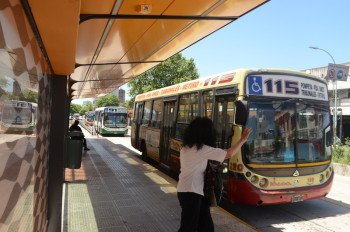2014: Buenos Aires, Argentina
Buenos Aires, the capital and largest city in Argentina with a population of three million, implemented several impressive sustainable transport projects in 2013. For its success promoting urban mobility, reducing emissions, and improving safety, Buenos Aires won the 2014 Sustainable Transport Award.
Buenos Aires opened a 23-km BRT corridor, Metrobus Sur, in 2013.
In 2013, the city launched two new corridors of their BRT system, Metrobus: the 23 km corridor of Metrobus Sur and the 3.5 km corridor of 9 de Julio. In addition, the city has transformed dozens of blocks in city center into a pedestrian-friendly environment, encouraging walking and cycling, and plans to continue this process in the next year. These changes are bringing big changes to Buenos Aires and promoting a culture that prioritizes people over cars.
Avenue 9 de Julio, known as the “widest avenue in the world” with more than 20 lanes of car traffic, underwent an impressive “transit makeover”. The city replaced car lanes with bus-only lanes and created a high-quality, median-aligned bus corridor with 17 stations, accommodating 11 bus lines and improving travel for 200,000 passengers per day. Although the project was often politically difficult, the results are speaking for themselves: across the board, passengers have reduced their travel time by an average of 30 minutes per bus ride. It used to take more than 40 minutes to cross the city. Now it takes an average of 14.
The 9 de Julio Avenue corridor project is part of a citywide Sustainable Mobility Plan initiated in 2009. The plan includes the pedestrianization of more than 100 blocks of the Microcentro area, an extension of the public bicycle share system, a 300 km bicycle-lane network, interventions prioritizing pedestrian activity and public transport, traffic calming and road safety infrastructure, and a sweeping on-street parking-reform project planned for 2014 that will incorporate best practices from around the world to combat illegal parking and improve traffic flow.
9 de Julio avenue before its transformation
Buenos Aires pedestrianized dozens of blocks in the city’s microcentro.
9 de Julio avenue today, with high quality BRT and increased pedestrian access
“Buenos Aires took the world’s widest avenue, with more than 20 lanes of car traffic, and transformed it into a world-class BRT corridor, cutting travel time in half for more than 200,000 commuters per day.” said Walter Hook, Chief Executive Officer of ITDP. “The downtown area, known as the microcentro, is a completely new pedestrian experience. They city reconstructed the streetscape with seating, bollards, way finding, and redesigned intersections that give priority to the pedestrian. This sends a powerful message that this is a city for people, not just for cars.”
In addition to the 9 de Julio corridor, Buenos Aires opened the Metrobus Sur BRT corridor in September 2013. Metrobus Sur runs in two branches, General Roca and Fernandez de la Cruz, with an interchange Puente La Noria with Constitution transport hub. The BRT has 32 stations, and carries 250,000 passengers per day.
Metrobus Sur’s designated lane will benefit 21 other bus lines. Residents of the eight neighborhoods along the corridor have already seen a 20 percent commute time reduction, a reduction in traffic noise and pollution, and the project is expected to have a development impact on these neighborhoods for years to come.
New protected cycle lanes in Buenos Aires’ downtown.
Dozens of redesigned intersections improved pedestrian safety by increasing pedestrian visibility and decreasing crossing distances.
Click here to view our case study on Buenos Aires.






